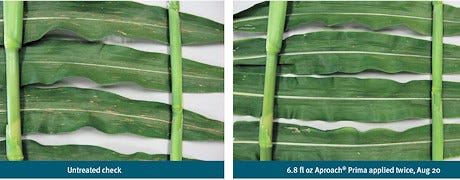October 29, 2013

The fungicide market has exploded in recent years as farmers work to control yield-robbing diseases in new ways. The strobilurin class of fungicides have offered producers a new way to tackle tough diseases and along the way also bring benefits to the treated crop as well.
In 2013, DuPont launched Aproach, a strobilurin with a unique feature versus the competition - it could be used to suppress white mold. "We had a nice launch in 2013 with straight Aproach," says Todd Robran, foliar health portfolio manager, DuPont. "The key as we go forward is to help manage white mold, which sets it apart. Aproach redistributes in the crop canopy and can control soybean white mold deep in the canopy.

TREATMENT COMPARISON: Northern leaf spot at left is defeated by Aproach Prima at right. Aproach Prima is a new dual-mode fungicide formulation.
For 2014, DuPont is turning up the heat with DuPont Prima, which recently received registration by the U.S. Environmental Protection Agency. Aproach Prima brings along a triazole to deliver a second mode of action at application. This one-two punch offers Mid-South farmers a way to tackle tough diseases including resistant frogeye leaf spot, which has been a problem in the region.
However, for the Midwest straight Aproach remains the key product. The key is that to control soybean white mold it takes 9 ounces of Aproach to do the job. In the Mid-South where white mold is less of a problem and other disease are more troublesome, Aproach Prima takes over.
Robran explains that with Aproach Prima the user gets 6.8 ounces of the strobilurin in the mix along with siproconazole, which is a unique triazole in the market. This adds protection from resistance and provides the user peace of mind when controlling frogeye leaf spot in the region.
Robran says that the application timing in the Mid-South for Aproach Prima will be that 6.8-ounce rate at R3 or R4. And the 6.8-ounce rate is the same for corn as well in that region. And growers could start with straight Aproach at V5 to V8, and then at VT or later use Aproach Prima in a second application.
DuPont is part of the Fungicide Resistance Action Committee, which monitors plant diseases and works to identify the best ways to stop resistance from forming. This new two-mode Aproach Prima is one big step in that direction for the fungicide market.
In field tests ahead of registration, DuPont reports that Aproach Prima decreased soybean rust by 92% over an untreated control plot and delivered a 16-bushel yield bump over competitive products. In seed corn, Aproach Prima maintained green leaf area more effectively and increased yield by 11 bushels per acre versus untreated acres. And in a winter wheat trial, Aproach Prima reduced the severity of powdery mildew by nearly 99%, and Septoria tritici - the cause of Septoria leaf blotch - by nearly 85%.
As you're making that fungicide order this fall for 2014, there will be more choices. You can learn more about Aproach Prima by visiting aproachprima.dupont.com.
Here's a quick look at the diseases Aproach Prima tackles, by crop:
Soybeans - strobilurin-resistant frogeye leaf spot; septoria brown spot; downy mildew and soybean rust.
Corn - Northern corn leaf blight, gray leaf spot, Northern corn leaf spot and Southern rust.
Wheat - powdery mildew; rusts; septoria
About the Author(s)
You May Also Like






